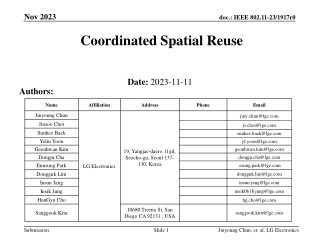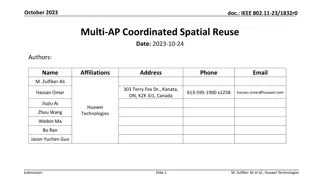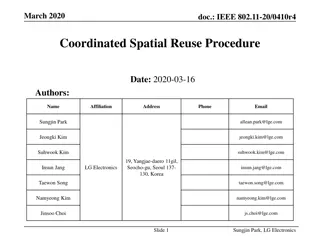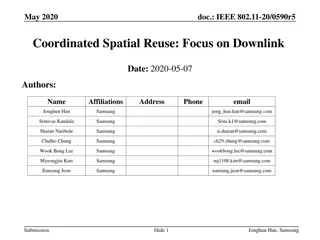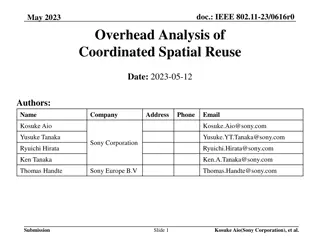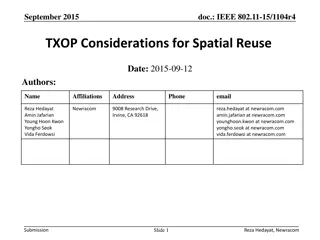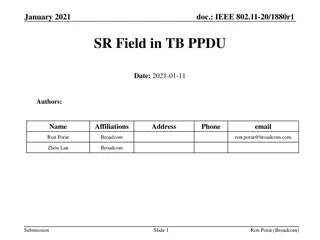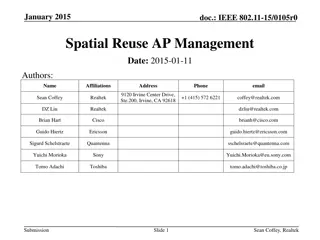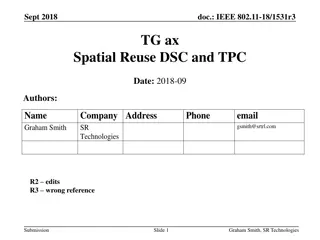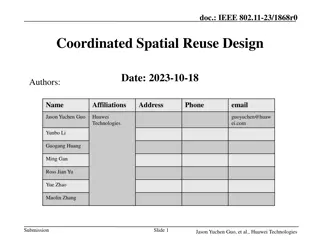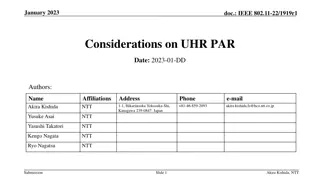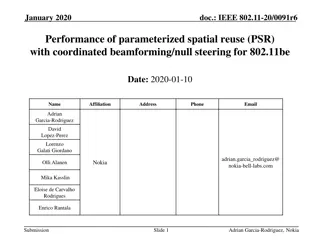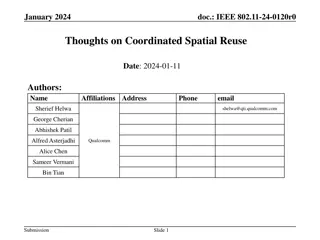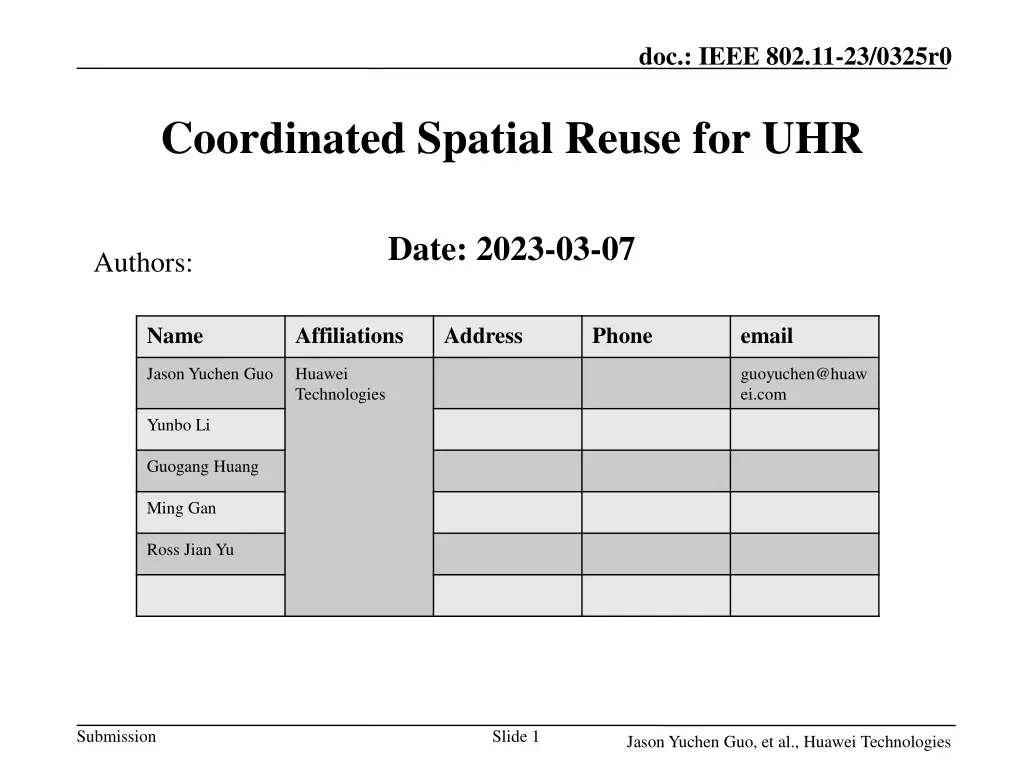
Coordinated Spatial Reuse for UHR in IEEE 802.11-23
Explore the concept of Coordinated Spatial Reuse (Co-SR) in the context of Multi-AP coordination in IEEE 802.11-23. This contribution delves into the operations, benefits, and implementations of Co-SR, offering insights into how it enhances channel access and controls interference, making it a promising candidate for next-generation wireless networks.
Download Presentation

Please find below an Image/Link to download the presentation.
The content on the website is provided AS IS for your information and personal use only. It may not be sold, licensed, or shared on other websites without obtaining consent from the author. If you encounter any issues during the download, it is possible that the publisher has removed the file from their server.
You are allowed to download the files provided on this website for personal or commercial use, subject to the condition that they are used lawfully. All files are the property of their respective owners.
The content on the website is provided AS IS for your information and personal use only. It may not be sold, licensed, or shared on other websites without obtaining consent from the author.
E N D
Presentation Transcript
doc.: IEEE 802.11-23/0325r0 Coordinated Spatial Reuse for UHR Date: 2023-03-07 Authors: Name Affiliations Address Phone email Jason Yuchen Guo Huawei Technologies guoyuchen@huaw ei.com Yunbo Li Guogang Huang Ming Gan Ross Jian Yu Submission Slide 1 Jason Yuchen Guo, et al., Huawei Technologies
doc.: IEEE 802.11-23/0325r0 Introduction Multi-AP coordination has been extensively discussed in TGbe, as well as EHT SG. Many modes of multi-AP coordination have been proposed and analyzed, including: Joint transmission (JT) ; Coordinated Beamforming (co-BF) ; Coordinated UL MU MIMO (co-UL-MU-MIMO) ; Coordinated Spatial Reuse (co-SR) ; Coordinated OFDMA (co-OFDMA), Coordinated TDMA (co-TDMA) Moreover, several motions have passed in TGbe, aiming to define the above modes [1]. However, due to the introduction of MLO in MAC, and 320MHz+4K QAM in PHY, the PAR of EHT can be satisfied already, making Multi-AP coordination a good candidate for the next generation, which can be seen from the long contribution list in UHR on this feature [2-15]. Submission Slide 2 Jason Yuchen Guo, et al., Huawei Technologies
doc.: IEEE 802.11-23/0325r0 Co-SR Recap (1) Among all the modes in Multi-AP coordination, we focus on co-SR in this contribution. The basic operations of co-SR is illustrated in the figure below: After successfully contending the channel, the sharing AP can initiate the co-SR transmission by sending a co-SR Trigger frame. The sharing AP and the shared APs use the same channel for data transmission at the same time. AP1 (BA) Co-SR Trigger Frame DL Data Frame (or basic TF) (sharing AP) AP2 (BA) DL Data Frame (or basic TF) (shared AP) STA1 BA (or UL Data Frame) (Associated with AP1) BA (or UL Data Frame) STA2 (Associated with AP2) Submission Slide 3 Jason Yuchen Guo, et al., Huawei Technologies
doc.: IEEE 802.11-23/0325r0 Co-SR Recap (2) SR transmitter in this region will cause more interference One of the reasons that we focus on co-SR is that it is a natural extension to the existing spatial reuse (SR) scheme defined in TGax SR is defined as a distributed channel access scheme, where the interference to the ongoing transmission is not controllable Comparatively, co-SR can control the interference to the primary transmission by choosing the appropriate shared AP, and the corresponding TX power. -82dBm -72dBm Non-AP STA ongoing transmission Non-AP STA AP Non-AP STA SR transmitter in this region will cause less interference Submission Slide 4 Jason Yuchen Guo, et al., Huawei Technologies
doc.: IEEE 802.11-23/0325r0 Co-SR Recap (3) Another reason that we focus on co-SR is that it provides a nice balance between performance gain and implementation complexity Comparing with co-OFDMA co-TDMA, it increases throughput and decreases delay, but the latter can not provide throughput gain Comparing with JT and co-BF, it doesn t need the multi-AP sounding procedure, resulting in less overhead and implementation complexity. Submission Slide 5 Jason Yuchen Guo, et al., Huawei Technologies
doc.: IEEE 802.11-23/0325r0 Performance gain Some simulation level performance gain is illustrated in [16-18] [9] Besides, we also built a hardware demo to test the actual performance of co-SR Settings: AP number: 2 Inter-AP distance: 22m AP TX power: 15dBm Non-AP STA number: 3 per AP BW: 40MHz NSS per non-AP STA: 2 Traffic: DL full buffer (UDP) Test duration: 5min Non-AP STA placement: case1 near to the AP ; case2 medium distance to the AP Averag e SINR Co-SR off/on Test 1 Test 2 Test 3 Averag e Throughpu t Gain Case 1 33.8dB off 473 476 476 475 on 598 608 604 603.33 27.02% Case 2 25.2dB off 388 390 384 387.33 on 455 462 455 457.33 18.07% Unit: MBps Submission Slide 6 Jason Yuchen Guo, et al., Huawei Technologies
doc.: IEEE 802.11-23/0325r0 Conclusion We suggest that the TG for UHR should define co-SR Hardware test results show that the throughput gain of co-SR can be up to 27% Submission Slide 7 Jason Yuchen Guo, et al., Huawei Technologies
doc.: IEEE 802.11-23/0325r0 References [1] 11-20-1935-66-00be-Compendium of straw polls and potential changes to the Specification Framework Document - Part 2 [2] 11-22-1512-00-0uhr-Multi-AP Coordination for UHR [3] 11-22-1515-00-0uhr-A candidate feature: Multi-AP [4] 11-22-1516-00-0uhr-Considerations on Multi-AP Coordination [5] 11-22-1567-00-0uhr-C-OFDMA throughput analysis in various mesh backhaul scenarios [6] 11-22-1530-00-0uhr-Multi AP coordination for next-generation Wi-Fi [7] 11-22-1556-00-0uhr-Multi-AP Coordination for Low Latency Traffic Delivery [8] 11-22-1394-00-0uhr-Virtual BSS And Multi AP Transmissions [9] 11-22-1822-00-0uhr-Recap on Coordinated Spatial Reuse Operation [10] 11-22-1895-00-0uhr-Thoughts on M-AP Coordination Principles [11] 11-22-1899-00-0uhr-Multi-AP Operation for Low Latency Traffic Delivery - Follow up [12] 11-22-1821-00-0uhr-System Level Simulation of Co-BF and Joint Tx [13] 11-22-2188-00-0uhr-Joint Transmission for UHR -A Refresher and New Results [14] 11-23-0041-00-0uhr-Considerations on Coordinated TDMA [15] 11-23-0058-00-0uhr-Spatial Reuse in Coordinated M-AP for UHR [16] 11-19-0103-01-0eht-ap-coordination-in-eht [17] 11-20-0576-01-00be-coordinated-spatial-reuse-protocol [18] 11-20-0107-01-00be-multi-ap-coordination-for-spatial-reuse Submission Slide 8 Jason Yuchen Guo, et al., Huawei Technologies

